This spring I’ve had several opportunities to photograph the courtship “flight display” of the male Northern Mockingbird. While singing continuously from his perch he jumps almost straight up about six feet as he flaps his wings a couple of times which displays those conspicuous white wing patches and then parachutes down with wings open to the same perch. This performance is repeated every 30-60 seconds or so for an extended period of time.
I’ve been somewhat disappointed with most of those shots for a variety of reasons, chief among them the fact that once the bird leaves his perch it’s very difficult to maintain or acquire focus on him. By the time focus has almost been acquired on him in the air he’s already dropped back down to the perch.
So two days ago I decided to change my tactics.
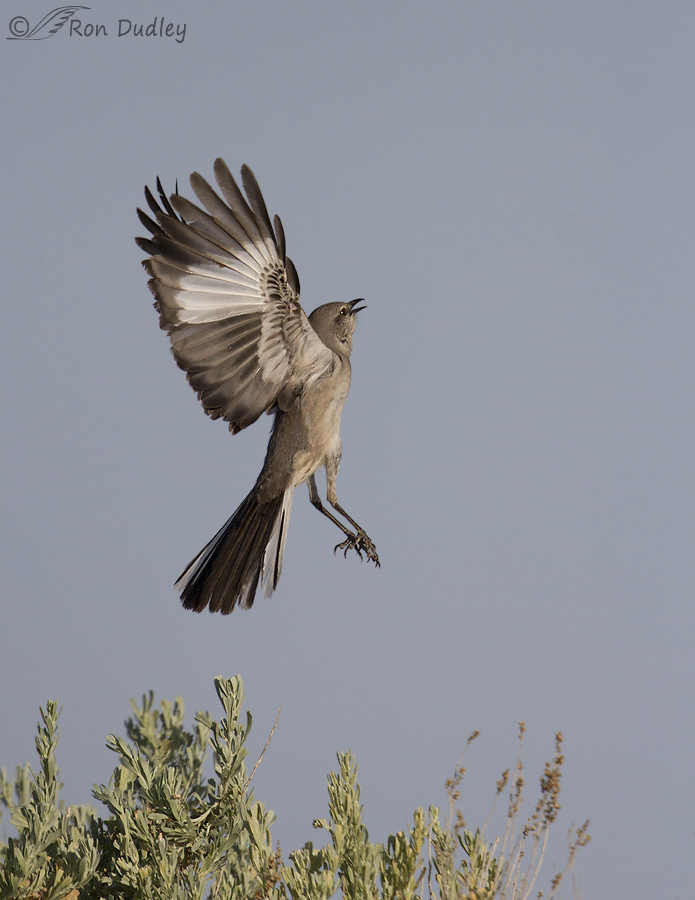
1/5000, f/6.3, ISO 500, Canon 7D, Canon EF500mm f/4L IS II USM +1.4 tc, not baited, set up or called in
Shooting vertically (rotating the camera 90 degrees) from my pickup with my huge lens is extremely awkward but I decided to try it because I could prefocus on the perched bird, recompose with just the bird and a small bit of the perch in frame, and have almost twice as much room up top in the frame to catch the bird in flight. And since he always jumps almost straight up I wouldn’t have to re-acquire focus on the bird in the air and I could fire a continuous burst to catch him in a variety of poses on the same flight.
Here the bird is just leaving the perch. With him this close to the perch focusing wouldn’t have been a problem with either technique.
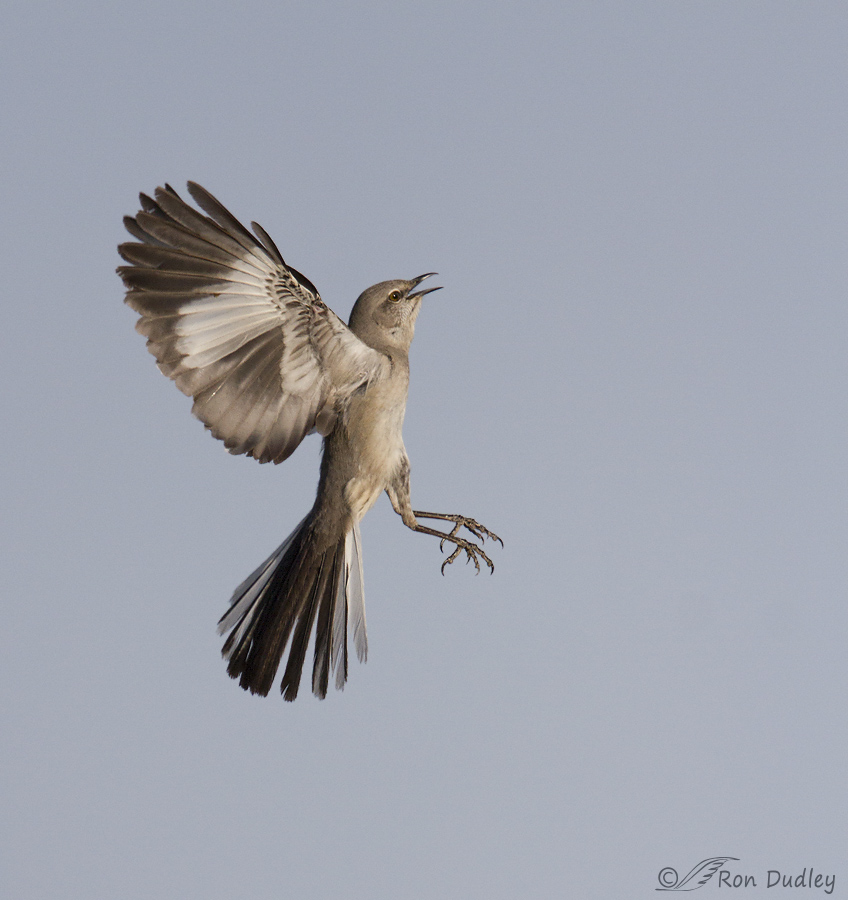
1/5000, f/6.3, ISO 500, Canon 7D, Canon EF500mm f/4L IS II USM +1.4 tc, not baited, set up or called in
But when he’s near the apex of his flight as he is here I would usually miss the shot. This image is cropped to about 50% of full frame.
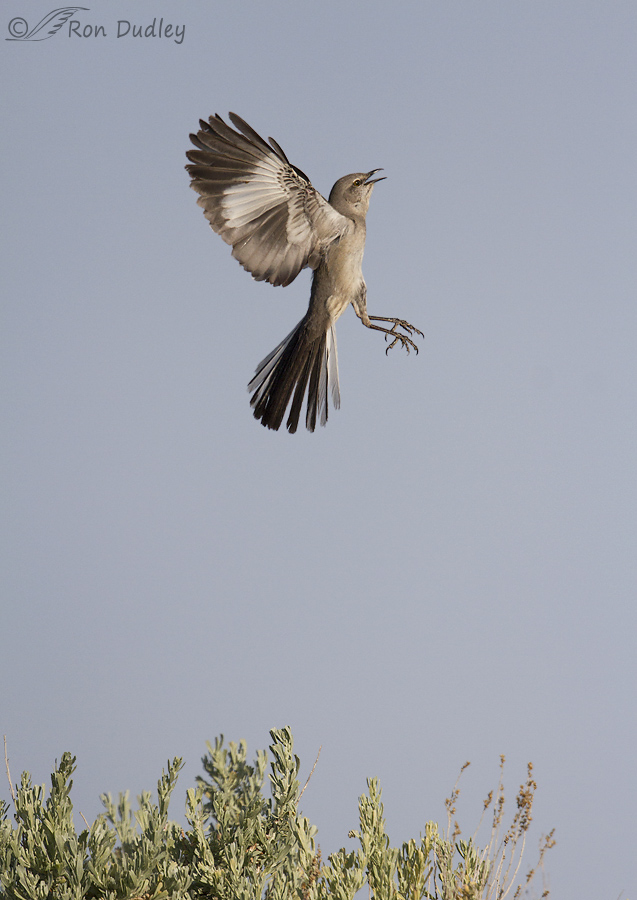
1/5000, f/6.3, ISO 500, Canon 7D, Canon EF500mm f/4L IS II USM +1.4 tc, not baited, set up or called in
Here’s the same image, cropped very little. Even though the bird is much smaller in the frame I actually prefer this version because the inclusion of the perch allows the viewer a better interpretation of the behavior. If I hadn’t been shooting vertically I wouldn’t have had enough room to include both bird and perch.
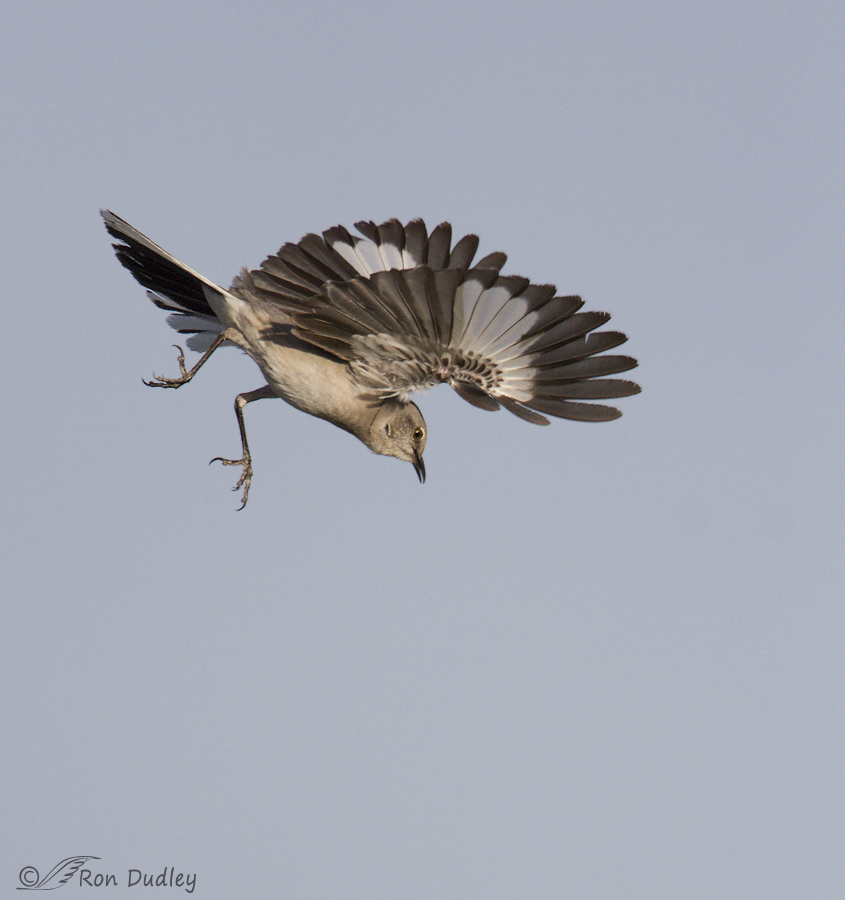
1/5000, f/6.3, ISO 500, Canon 7D, Canon EF500mm f/4L IS II USM +1.4 tc, not baited, set up or called in
Here’s another image where I used the same vertical shooting technique, only this time the mockingbird is beginning to parachute down to the perch. A relatively tight crop shows the bird well…
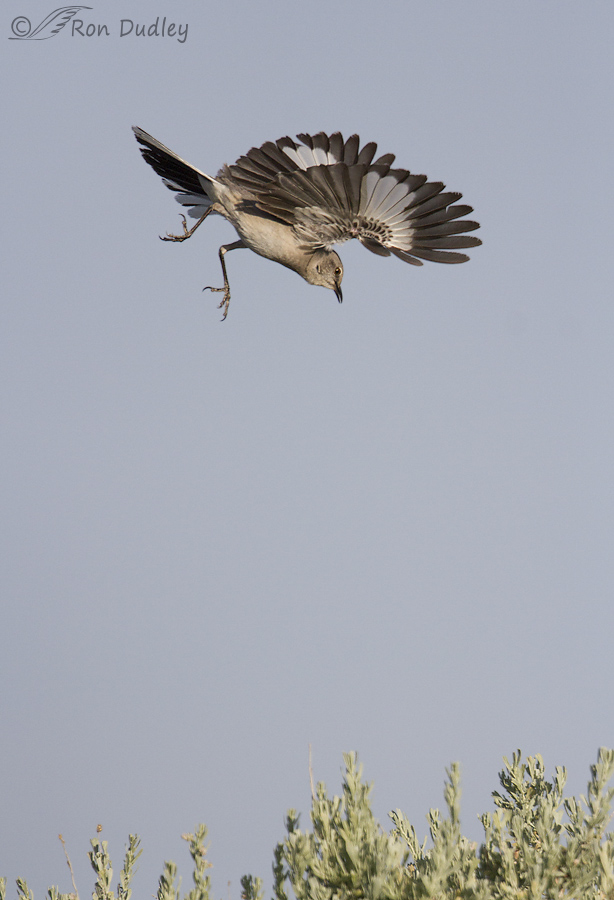
1/5000, f/6.3, ISO 500, Canon 7D, Canon EF500mm f/4L IS II USM +1.4 tc, not baited, set up or called in
but once again I prefer the version with very little cropping because it includes the perch. This was only possible because I was shooting vertically.
I didn’t even think of trying this technique until near the end of my last session with this mockingbird two days ago. If I get another opportunity with the behavior this spring I’ll give the technique a real workout.
Ron


I adore mockingbirds. We have a bachelor mocking bird near where I live. I enjoy listening to him sing then watching him FLING himself into the air. Amazing shots. Thanks so much for sharing them.
I’ve never seen this behavior.
Super images. Congrats.
Great shots. Glad you found a method to capture the behavior. I think Mockingbirds are permanent residents in our area, but I almost never see the mating display. You’ve inspired me to look for it more diligently.
I’ve had a similar problem trying to capture the dive of a Brown Pelican. I can’t keep the bird in the viewfinder and in focus if I try to track it continuously. Recently, I’ve been trying a variant of the method you describe – locking focus on the pelican at the peak of the climb before the dive, pointing the camera partway down my estimate of the downward trajectory, then initiating a burst of shots hoping the bird follows the predicted path. I’ve had a little luck, but still don’t have a good sequence from top of climb all the way through to entry of the water. I need to find them active when they are making shorter dives.
Mockingbirds supposedly moved North with the planting of “living hedges” by vets returning from WW II…or so I’m told. These vets wanted a family and sense of security of of a home of their own. They were sold “little boxes” (cookie cutter tract homes) by the hundrds, and also “sold” on planting cheap rosé bush hedges “for privacy”. These roses multiplied like mad and have become quite invasive in many areas, but, they also provided the rose hips the Mockingbirds liked. Then ones we’ve had here have sung all night under a street light. I’ve wondered about their health and well-being with this 24 hr. concerto. They sang at night in Florida,too, but usually by moon light. The “mockingbird” I saw recently was in silhouette, so although I thought it was a Mockingbird, it might have been a talented Catbird.
Patty, it sounds like you know the Malvina Reynolds song, “Little Boxes” that was originally written about South San Francisco. Given your description, I’d say your moonlight singer was a mockingbird. Catbirds are just not that talented. Mockingbirds are bigger than catbirds and have a different silhouette. Trust your gut as to what you saw… 🙂
Thanks for sharing your new strategy. Like you, I prefer the results that include the perch. Nicely done!
Beautiful, euphoric display…well captured! Living in Fallbrook, CA on 2+ acres, we enjoy abundant wildlife, which includes at least 2 pairs of courting Mockingbirds. It can become VERY noisy outside! I always marvel at the Mockingbird’s repertiore of ‘borrowed’ songs. One had included the sounds of the frogs nearby! Not sure how impressed the females were to hear that number. But then, sometimes you have to kiss a frog to find a prince…or so they say. :o))
Priceless!
Thanks, Jane.
I love these photos, and am very glad you figured out a technique for getting them. I have a long history with mockingbirds (including one who, when I was a child, used to wake me up every morning, cheeping loudly as it dive-bombed my cat who had apparently killed one of its babies), but still enjoy them. In the last few days I’ve noticed one that likes the wall in our back yard, and looks like it might be establishing a territory. I will definitely be keeping an eye out for this courtship behavior. This is a great example of the value of posting about common birds…
Susan, if you hear your bird singing incessantly with nary a stop (this time of year) it very well may be displaying like this. It’s a fun behavior to watch.
Common bird? Wash your mouth out. Mockingbirds are exotica here. And, as usual, I have an early morning cup of tea and am looking and learning (and yearning).
Sorry, Elephant’s Child. Mockingbirds have been very common everywhere I’ve lived – several widely divergent areas of the United States. That is truly the only thing common about them. They are the only one of the mimics that is multitalented with song – they are like little, feathered tape recorders. Other mimics, like the gray catbird, who does a wonderful job of imitating a cat that wanted dinner yesterday, can do one song well, but that’s all they do. My experience of mockingbirds are that they have a definite personality, are very opinionated, and have long memories (witness the one that had my cat literally petrified with fear, for quite a long time). I hope you do have the opportunity to encounter these sassy birds. I’m sure you would enjoy them.
We too have some talented mimics and some feisty charmers. Our wattle birds delight in swooping the cats (while swearing at them) and a magpie once (I swear deliberately) crapped copiously on the head of a cat looking up at it.
Feathered enchantment the world over.
Thanks for a good laugh. I needed that today.
“Jumping for joy”, is what immediately came to mind…the bird LOOKS euphoric, whatever his real feelings are. I especially love the second and third images. The second looks so happy and the third shows how high he flings himself. I think, MAYBE, we have another mockingbird….thought I heard one singing yesterday. We heard them all the time in Florida and then when we moved North, had one here. I really miss them, but have never seen this behavior. Wonderful!
I’m relatively unfamiliar with mockingbirds, Patty. Until this year I saw very few of them around here but this year there seems to be a lot of them. Makes me wonder if it might be related to climate change…
If we keep doing the same thing over and over we don’t evolute. Pushing the limits is the answer.
Good job. And with time it will be better and better, no doubt about it.
Thanks for sharing your experiments.
I appreciate the encouragement, Jorge. I’m naturally very much a creature of habit so I have to keep reminding myself to think out of the box once in a while…
Wow! The technique certainly produced spectacular results! Thanks so much for sharing!
Charlotte
Thank you, Charlotte.
Breathtaking!! Well done, Ron!!!!!
Thanks, Lois.